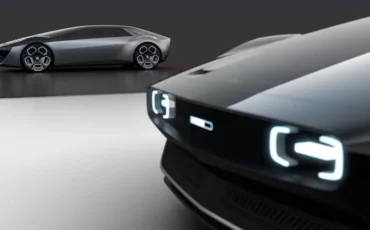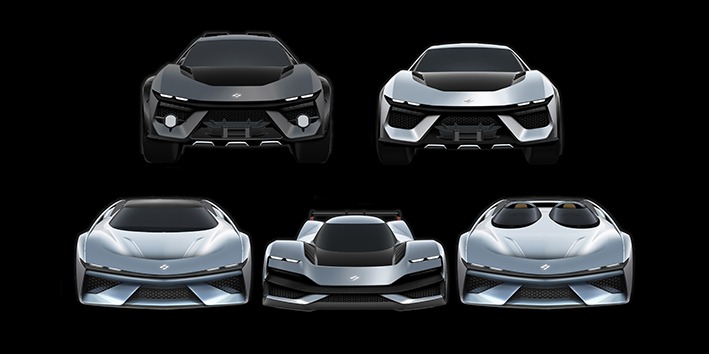
A new begininng
The new car manufacturer founded by Bruno Laffite, grandson of F1 driver Jaques, makes its debut at the Miami Grand Prix. Sporty DNA and made-in-Italy style signed by Giorgetto and Fabrizio Giugiaro’s GFG Style.
Five Hypercars
The new Laffite Automobili brand for the production of full-electric hypercars debuts at the Formula 1 Grand Prix in Miami. A deliberately ‘Italian’ brand, both in the choice of location, in Turin, and in the development of engineering and design, entrusted to GFG Style of Giorgetto and Fabrizio Giugiaro. The founder of the new car manufacturer is Bruno Laffite, grandson of Jaques, Formula 1 driver between 1974 and 1986, and a driver himself, among the best of his generation. There are five models ready to be launched on the market, Atrax, Barchetta and LM1: three specific architectures, plus two other evolutions, built in record time under the stylistic direction of Fabrizio Giugiaro.
The Atrax & Atrax Stradale Hyper SUV
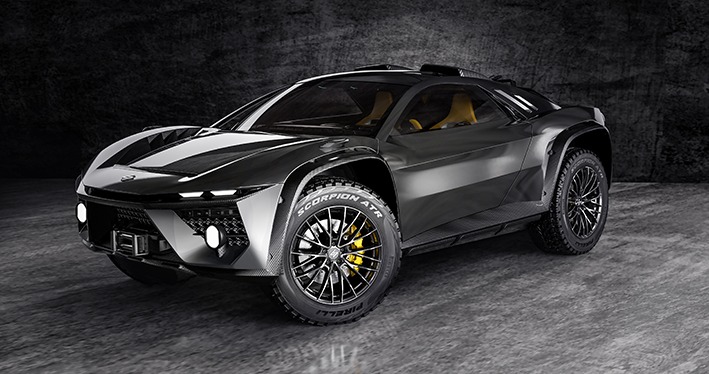
Under the stylistic direction of Fabrizio Giugiaro, GFG Style has designed and built for Laffite Automobili the Atrax, an extreme hyper-suv for off-road use, and a more road-going version, the Atrax Stradale. “The design of the Atrax and Atrax Stradale derives from my long design experience introduced as long as ten years ago,” explains Fabrizio Giugiaro, “and as often happens in my vision for the future, in addition to design I try to introduce new types of cars, as in this case the Hyper Suv. Only today many car manufacturers are introducing it to the market, but in the case of Laffite Automobili we have gone further, both in terms of design and use”. Atrax proposes itself as a sporty SUV with an exaggerated and extreme shape with significant volumes and generous roominess, allowing a 2+1 seat architecture. The starting point for the car’s design is the enormous all-terrain wheels with a diameter of almost a metre that generate important mudguards modelled with applied wheel arches, with very refined shapes in exposed carbon. The side is simple with a well-proportioned beltline and a door that lifts like a butterfly with a single window that drops regularly. The special feature of the door is the presence of the ‘detached’ A-pillar that acts as an aerodynamic element at the most delicate point of the flows, thus creating a unique design.
The Barchetta & Barchetta Coupé
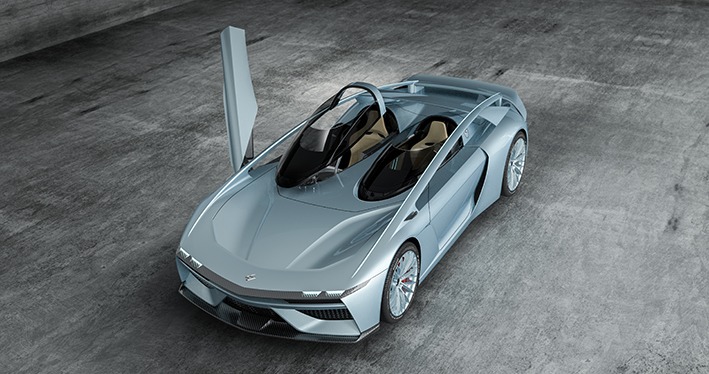
The Barchetta and Barchetta Coupé project are the most complex in every respect and very innovative. The casr has two strong particularities: two separate seats, two individual windscreens and the halo, derived from Formula 1, which is decidedly unusual for an open, homologated car that gives maximum safety. The choice of a double dome was inspired by an idea of Giorgetto Giorgetto from 1959, later reproposed in the Aztec prototype of 1988. “The last formal experimentation of a similar scheme was proposed with the Dora concept car of 2020, which is actually the beginning of this project,” explains Fabrizio Giugiaro. “The double cockpit surmounted by the large Halo-type structures determines the real design innovation: to access the interior, the two cockpits rise independently but at the same time as the doors, creating a spectacular movement. The front end confirms Laffite’s stylistic features with the particularity of the double headlamps clearly delineated and separated by a large integrated wing. The stylistic element of the design is determined by the arched structure that makes the flank line continuous at the top and rests on the large wing-shaped B-pillars. Simple side treatment in the door that is exaggerated in the large rear wing. The rear is characterised by a continuous upper tail light that is also a spoiler, under which there is an exposed carbon part that integrates the three elements on each side to give additional tail light functions. The tail closes at the top with a spoiler attached to the two halo ends.
The LM1
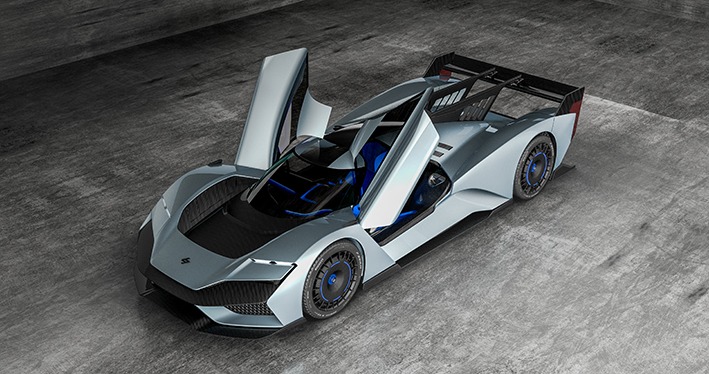
Laffite Automobili’s most extreme model dreams of the racetrack: the new LM1 hypercar has the shape of a vehicle essentially intended for racing, but which is homologated for road use, with unexpected comfort for such a car. The low front end is well characterised by the headlights of the new Laffite family feeling. The central part of the bonnet is black and houses a large central air outlet, while on the painted mudguards are active fins. The dome is very narrow, teardrop-shaped, and with a maximum width of 90 cm as required by regulations for racing cars of this type. The wrap-around windscreen continues in the doors, creating side windows that descend to the B-pillar, which has a similar graphic design to the one on Atrax but here generates two small windows. “The lines are drawn by the wind, but thought out in all its stylistic aspects to make it even more attractive and uncompromising,” explains designer Fabrizio Giugiaro. “Laterally, the dome is pulled taut and descends at the rear as far as the diffuser and has the unique feature of having two pillars above it with a dual function. “The first to support the large active spoiler and the second to better convey the aerodynamic flow,” explains Giugiaro, “a real innovation that I bet we will soon see in future racing cars.
Fabrizio Giugiaro's vision
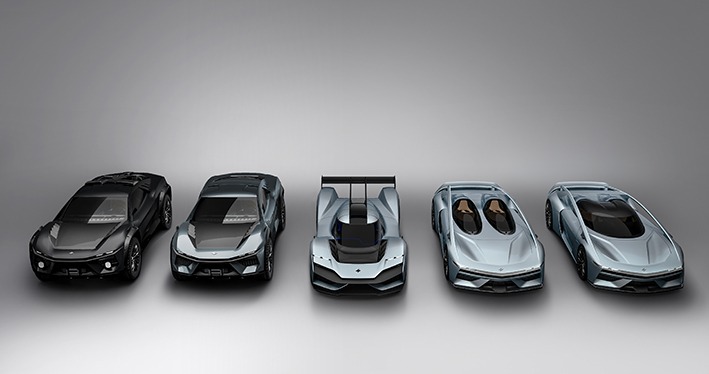
Fabrizio Giugiaro created the architecture and design for the new family of hyper cars, identifying the stylistic features that characterise the new Laffite Automobili brand and applying them to all five models. “This was my real challenge,” explains the designer, “to design original cars with completely different and unique characteristics. The first objective, the front of the car and its expression through its light clusters, to characterise the brand image. And so, at first glance, all five models have the same design sequence: lower wings, a horizontal bar integrating the light clusters and the air outlets on the well-shaped bonnets; but it is above all the lit Drl lights that give the real distinguishing mark. Everything has been interpreted with inspiration from the safety innovations adopted in motor racing. “On the Barchetta, the true hallmark of the entire brand is evident,” explains Giugiaro. “On the sides, the B-pillars have the same graphic design, but decidedly different proportions and functions. More personalised, on the other hand, are the rear of the cars with many functional elements in common, such as the diffuser and the ailerons that integrate the typical Formula 1 lights. And as far as the interior is concerned, the styling language is the same for all models, using the same elements: the specially designed vents and ceiling lights are an example of this.


